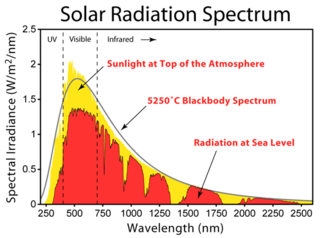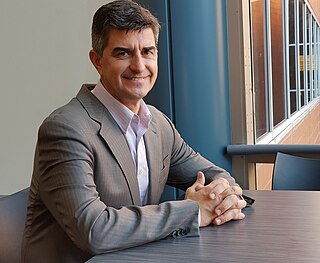Related Research Articles
Nanoengineering is the practice of engineering on the nanoscale. It derives its name from the nanometre, a unit of measurement equalling one billionth of a meter.

A rectenna is a special type of receiving antenna that is used for converting electromagnetic energy into direct current (DC) electricity. They are used in wireless power transmission systems that transmit power by radio waves. A simple rectenna element consists of a dipole antenna with an RF diode connected across the dipole elements. The diode rectifies the AC induced in the antenna by the microwaves, to produce DC power, which powers a load connected across the diode. Schottky diodes are usually used because they have the lowest voltage drop and highest speed and therefore have the lowest power losses due to conduction and switching. Large rectennas consist of an array of many power receiving elements such as dipole antennas.

Nanoelectromechanical systems (NEMS) are a class of devices integrating electrical and mechanical functionality on the nanoscale. NEMS form the next logical miniaturization step from so-called microelectromechanical systems, or MEMS devices. NEMS typically integrate transistor-like nanoelectronics with mechanical actuators, pumps, or motors, and may thereby form physical, biological, and chemical sensors. The name derives from typical device dimensions in the nanometer range, leading to low mass, high mechanical resonance frequencies, potentially large quantum mechanical effects such as zero point motion, and a high surface-to-volume ratio useful for surface-based sensing mechanisms. Applications include accelerometers and sensors to detect chemical substances in the air.

Pulickel Madhavapanicker Ajayan, known as P. M. Ajayan, is the Benjamin M. and Mary Greenwood Anderson Professor in Engineering at Rice University. He is the founding chair of Rice University's Materials Science and NanoEngineering department and also holds joint appointments with the Department of Chemistry and Department of Chemical and Biomolecular Engineering. Prior to joining Rice, he was the Henry Burlage Professor of Material Sciences and Engineering and the director of the NYSTAR interconnect focus center at Rensselaer Polytechnic Institute until 2007. Known for his pioneering work of designing and carrying out the first experiments to make nanotubes intentionally.
Phaedon Avouris is a Greek chemical physicist and materials scientist. He is an IBM Fellow and was formerly the group leader for Nanometer Scale Science and Technology at the Thomas J. Watson Research Center in Yorktown Heights, New York.
The history of nanotechnology traces the development of the concepts and experimental work falling under the broad category of nanotechnology. Although nanotechnology is a relatively recent development in scientific research, the development of its central concepts happened over a longer period of time. The emergence of nanotechnology in the 1980s was caused by the convergence of experimental advances such as the invention of the scanning tunneling microscope in 1981 and the discovery of fullerenes in 1985, with the elucidation and popularization of a conceptual framework for the goals of nanotechnology beginning with the 1986 publication of the book Engines of Creation. The field was subject to growing public awareness and controversy in the early 2000s, with prominent debates about both its potential implications as well as the feasibility of the applications envisioned by advocates of molecular nanotechnology, and with governments moving to promote and fund research into nanotechnology. The early 2000s also saw the beginnings of commercial applications of nanotechnology, although these were limited to bulk applications of nanomaterials rather than the transformative applications envisioned by the field.
Nanocircuits are electrical circuits operating on the nanometer scale. This is well into the quantum realm, where quantum mechanical effects become very important. One nanometer is equal to 10−9 meters or a row of 10 hydrogen atoms. With such progressively smaller circuits, more can be fitted on a computer chip. This allows faster and more complex functions using less power. Nanocircuits are composed of three different fundamental components. These are transistors, interconnections, and architecture, all fabricated on the nanometer scale.
The following outline is provided as an overview of and topical guide to nanotechnology:

An optical rectenna is a rectenna that works with visible or infrared light. A rectenna is a circuit containing an antenna and a diode, which turns electromagnetic waves into direct current electricity. While rectennas have long been used for radio waves or microwaves, an optical rectenna would operate the same way but with infrared or visible light, turning it into electricity.
Timothy S. Fisher is an American educator, engineer and expert in the application of nanotechnologies. He is a former professor of mechanical engineering at the School of Mechanical Engineering, Purdue University and Director, Nanoscale Transport Research Group-Purdue University. He currently teaches at the University of California, Los Angeles. He took his Bachelor of Science and doctorate at Cornell University in 1991 and 1998, respectively. Fisher became the chair of mechanical and aerospace engineering department at University of California, Los Angeles, starting July 1, 2018.

Mark C. Hersam is a professor of Chemistry and Materials Science Engineering at Northwestern University (2000–present) who, according to the National Science Foundation, has made "major breakthrough[s]" in the field of nanotechnology. He is a 2014 recipient of the MacArthur "Genius" Award and a 1996 Marshall Scholar. He is also an Associate Editor of ACS Nano. As of January 2022, he was cited over 54,500 times according to Google Scholar.

Yury Georgievich Gogotsi is a Ukrainian scientist in the field of material chemistry, professor at Drexel University, Philadelphia, PA since the year 2000 in the fields of Materials Science and Engineering and Nanotechnology. Distinguished University and Trustee Chair professor of materials science at Drexel University — director of the A.J. Drexel Nanotechnology Institute.
Jackie Yi-Ru Ying is an American nanotechnology scientist based in Singapore. She is the founding executive director of the Institute of Bioengineering and Nanotechnology (IBN).

Nicole Grobert FRSC FYAE is a German-British materials chemist. She is a professor of nanomaterials at the Department of Materials at the University of Oxford, fellow of Corpus Christi College, Oxford, and a Royal Society industry fellow at Williams Advanced Engineering. Grobert is the chair of the European Commission's Group of Chief Scientific Advisors.
Andrew R. Barron is a British chemist, academic, and entrepreneur. He is the Sêr Cymru Chair of Low Carbon Energy and Environment at Swansea University, and the Charles W. Duncan Jr.-Welch Foundation Chair in Chemistry at Rice University. He is the founder and director of Energy Safety Research Institute (ESRI) at Swansea University, which consolidates the energy research at the University with a focus on environmental impact and future security. At Rice University, he leads a Research Group and has served as Associate Dean for Industry Interactions and Technology Transfer.

Alan Kin-tak Lau is an engineer and academic based in Melbourne, Australia. He is the Pro Vice-Chancellor of Research Performance and Development at Swinburne University of Technology. He is also the Independent Non-Executive Director of King’s Flair International, the International Vice President and Trustee Board member of The Institution of Mechanical Engineers (2014-2019) and an Academic Advisor at Asia University. He also chairs the professional accreditation panel for APEC/IPEA for Korea. From 2014 to 2016, he was the Alex Wong/Gigi Wong Endowed Professor in Product Design Engineering at the Hong Kong Polytechnic University (HPKU). Currently, he is a Fellow of European Academy of Sciences and Arts, the European Academy of Sciences. Lau has conducted research in the field of Mechanical Engineering, Aerospace Engineering and Materials Engineering. His work has been focused on aerospace composites, Unmanned aerial vehicle, product design and engineering and bio-composites. Lau is recognized as Australian National Research Leader in Composite Materials 2019, published by The Australian Post. Currently, he is Director of Oceania Cybersecurity Centre Limited and Stawell Underground Physics Laboratory Company.
Gurpreet Singh is an associate professor at Kansas State University in the department of Mechanical and Nuclear Engineering. He is endowed by the Harold O. and Jane C. Massey Neff Professorship in Mechanical Engineering. Singh was born in Ludhiana, India; he currently resides in the U.S.
Hashem Rafii-Tabar is a British-Iranian professor and scientist within computational physics and nanoscience. He is primarily known for his contribution to the computational physics of nanostructures with important applications such as Carbon Nanotubes.
Ali Enver Aliev is a Crimean Tatar American physicist, research professor at the NanoTech Institute, and adjunct professor at Physics Department, The School of Natural Sciences and Mathematics, University of Texas at Dallas. In 2011 he was recognized an “Inventor of the year” by Time magazine His fields of current research interest are nanoscience and nanotechnologies, electrochromism and acoustics. He holds a number of invention patents from the United States Patent and Trademark Office (USPTO).
Clare McCabe is a British-American chemical engineer who is Cornelius Vanderbilt Chair of Engineering and Professor of Engineering at Vanderbilt University. She was elected Fellow of the American Association for the Advancement of Science in 2019. Her research makes use of molecular modelling to understand the properties of biological systems, fluids and nanomaterials.
References
- 1 2 "Professor Baratunde Cola". Georgia Institute of Technology, NanoEngineered Systems and Transport. Archived from the original on July 29, 2017. Retrieved September 4, 2017.
- 1 2 "Baratunde Cola". Georgia Institute of Technology, School of Materials Science and Engineering. Retrieved September 4, 2017.
- ↑ "Baratunde Cola, Mechanical Engineering". MLK Visiting Professors and Scholars Program.
- ↑ "Carbon nanotube rectenna directly converts light into electricity". Chemistry World. September 29, 2015. Retrieved September 4, 2017.
- ↑ "Alan T. Waterman Award 2017". National Science Foundation. July 25, 2017. Retrieved September 4, 2017.
- ↑ "Baratunde A. Cola, Carbice Nanotechnologies, Inc" . Retrieved September 4, 2017.
- ↑ "Carbice Corporation". Georgia Research Alliance. Retrieved September 4, 2017.
- ↑ "The Presidential Early Career Award for Scientists and Engineers: Recipient Details". National Science Foundation. Retrieved September 4, 2017.
- ↑ "Baratunde Cola Receives 2012 AAAS Early Career Award for Public Engagement with Science". AAAS. Retrieved September 4, 2017.
- 1 2 "NSF recognizes double ME alum with Waterman Award". Vanderbilt School of Engineering. April 20, 2017. Retrieved September 4, 2017.